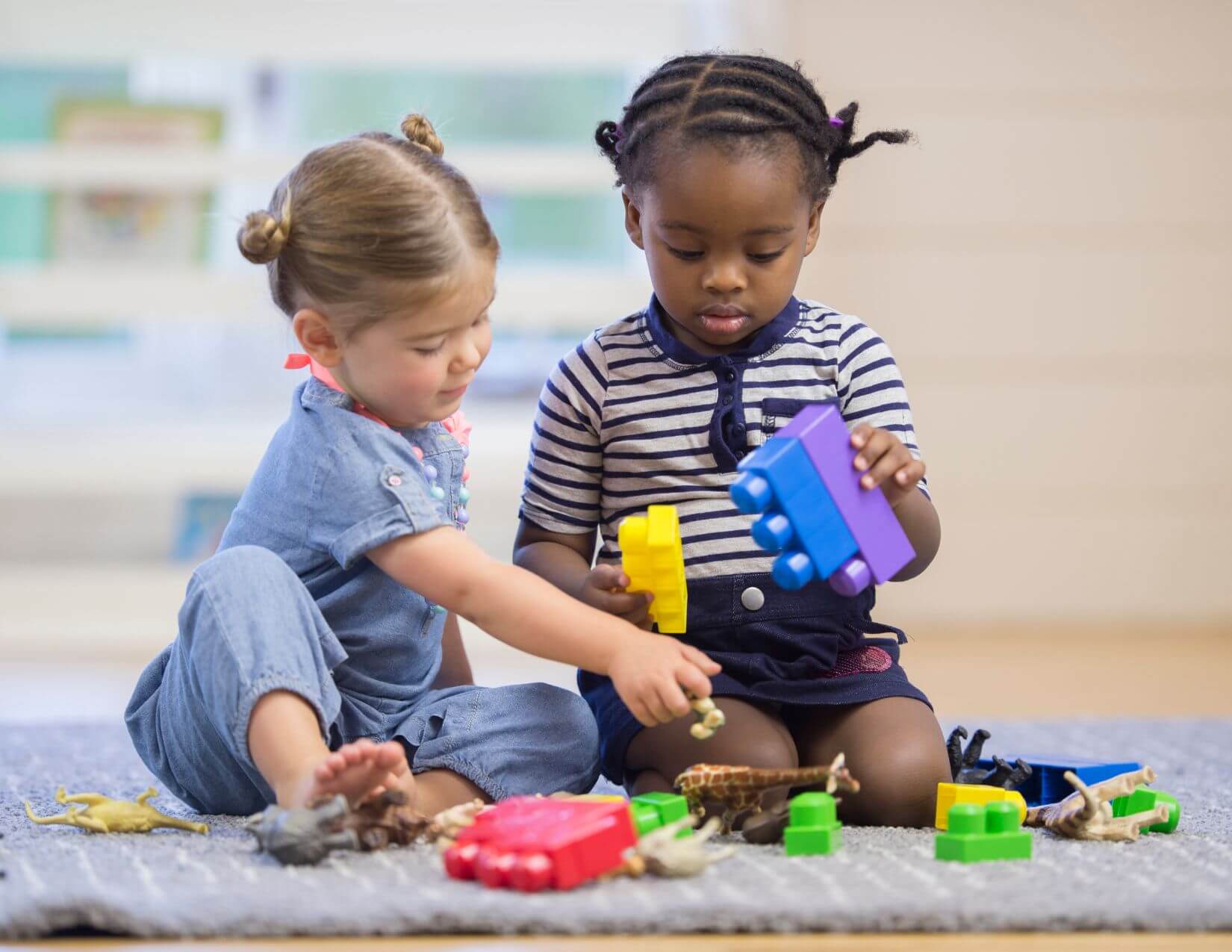What is Sharing and Showing?
Sharing and showing is a vital social skill that allows young children to connect with others by presenting a toy or object of interest.
Toddlers and preschool-age children naturally begin to engage in this behavior to build social connections and gauge others’ reactions to their interests. This skill helps establish shared enjoyment and social reciprocity, which are critical for healthy social development.
What Does “Sharing and Showing” Look Like?
- Sharing involves bringing an object to another person, handing it over while making eye contact, and waiting for their reaction to see if they enjoyed it.
- Showing is bringing an object to another person, looking for their reaction, and offering a smile or facial expression to share in the experience before returning to play.
While most pronounced in the preschool years, older children and teens continue this social connection when they do the following:
- Share comments or information about their day
- Notice a movie or show a peer would enjoy
- Bring a favorite snack for a friend’s birthday
Key Signs a Child is Struggling with Sharing and Showing
Difficulties in sharing and showing can indicate delays in social development.
You might notice these behaviors.
- Focusing solely on their own activity: The child is happy and engaged but doesn’t seek to include you or share the moment.
- Preferring independent play: The child consistently chooses their own activities and toys over playing with others.
- Lack of social offering: The child rarely brings you a toy or snack they think you would like, preferring to engage with objects alone.
- Dropping and running: They bring an object but hand it off without eye contact or waiting to see your response.
- Using a parent as a tool: The child clings to you or uses your hand to reach for a desired object without seeking social engagement.
- Interest in the object over the interaction: They enjoy the book, game, or snack, but don’t seem to care if others are enjoying it with them.
Understanding the Causes: Neurotype and Unique Wiring
When a child consistently fails to share and show—especially without eye contact or waiting for a reaction—it can be a sign of differences in social development. These differences are often associated with the Autism neurotype.
For children with this unique style of wiring, it is common to be more interested in toys and activities from their own perspective and to be less aware of the engagement and interests of others. This is why reciprocal play, sharing, showing, and shared enjoyment are key areas we observe in younger children to assess the quality of their social connection. It’s important to remember that all children on the Spectrum are loving, intelligent, and wonderful—they simply process and express social information and connection in their own way. When this skill is absent, it may indicate a developmental difference that warrants evaluation.
What You Can Do: Strategies for Shared Enjoyment
To help young children build these skills, focus on establishing shared enjoyment and social reciprocity.
Five Strategies to Practice Shared Enjoyment
- DO join play with warmth: Engage in physical play like gentle tickles and hugs (honoring your child’s boundaries). For many children, physical connection is an easier starting point for shared enjoyment.
- DO initiate shared enjoyment in their interests: Take a genuine interest in your child’s favorite activities—baking, building, gardening, or reading. Devote uninterrupted time to engage in that activity with them.
- DO expand the shared interest: Slowly and comfortably encourage your child to enjoy their interest with others. For a young animal lover, this might mean a trip to the zoo. The goal is a shared connection around a shared passion.
- DO mix interactions at home: Ensure your child has time for independent relaxation, but also schedule family time for shared activities like games, movies, and cooperative tasks.
- DO use timers: Timers can be a helpful, neutral tool for managing transitions between activities if your child struggles to shift their attention.
When to Seek Professional Help
If you notice your child is not sharing or showing, start observing their social skills closely. If you find yourself frequently making statements like, “He’s just independent,” “He likes what he likes,” or “He can entertain himself for hours,” it is a good time to consult an expert.
It is recommended to seek a psychologist who specializes in early child development and evaluations. Early intervention can make a massive difference, as brain plasticity in young children is fantastic. Look for an ABA therapist who uses Pivotal Response Techniques or other similar models like Denver Early Start. Keep in mind that a diagnosis from a testing psychologist is often necessary to access these services.
Professional and Book Resources
- Association for Science in Autism Treatment, to learn more about effective and research-based interventions for Autism: www.Asatonline.org
- Assessment of Autism Spectrum Disorder: Critical Issues in Clinical, Forensic, and School Settings by Kroncke, Willard, & Huckabee (2016)
- BCBA and ABA therapy team: To help with behavior management. A Board Certified Behavior Analyst leads an ABA team that includes BCaBAs, line therapists called RBTs, and this therapy includes direct pivotal response treatment with your child as well as parent consultation and monthly team meetings for data review. This treatment has the most research to support its effectiveness with social symptoms like sharing and showing in young children ages 2-7.
- Child Find: To evaluate a young child who is lagging in social skills. They can test skill levels, provide free preschool and therapies, and help you find testing psychologists in your community who can evaluate for autism.
- Child, Family, School, Community: Socialization and Support by Berns, Roberta M. (2010)
- Early Childhood Development: A Multicultural Perspective by Trawick-Smith, Jeffrey (2013)
- Educating Young Children with Autism Spectrum Disorders by Barton, Erin: nasponline.org
- Koegel Autism Center, University of California at Santa Barbara: education.ucsb.edu/autism
- A Parent’s Guide to High Functioning Autism Spectrum Disorder: How to meet the challenges and help your child thrive by Ozonoff, Sally, Dawson, Geraldine & McPartland, James C. (2014)
- School psychologist: To support your child at school with social groups, individual support, parent consultation to help determine the best peer models, and consultation with a teacher.
- Social group therapy: To work on social skills. With older children, a mix of cognitive-behavioral psychotherapy and social group therapy led by a psychologist, speech pathologist, or licensed therapist is recommended.
- Social skills books and resources for ASD by Jed Baker (Retrieved 2017): Social Skills Training Project
- Social Skills Picture Book for High School and Beyond by Jed Baker (2006)
- Speech pathologist: To work on pragmatic (social) language and conversation skills with a child individually or in a group setting.
- Testing psychologist: To conduct an evaluation of social skills, cognition, language, and other areas. An evaluation should result in a profile of strengths and weaknesses, any relevant diagnoses, as well as prioritized recommendations for treatment.
- The New Social Story Book, Revised and Expanded 10th Anniversary Edition by Gray, Carol & Attwood, Tony (2010)
- UCSB PEERS Clinic: semel.ucla.edu/peers




